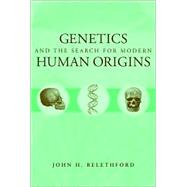
Note: Supplemental materials are not guaranteed with Rental or Used book purchases.
Purchase Benefits
What is included with this book?
Dr. Relethford completed his BA, MA, and Ph.D. degrees in anthropology at the State University of New York at Albany. He worked as a postdoctoral research scientist at the Southwest Foundation for Biomedical Research in San Antonio before joining the faculty at the State University of New York at Oneonta. He is currently Distinguished Teaching Professor and Chair of the Department of Anthropology at SUNY-Oneonta, and is a recipient of the SUNY Chancellor's Award for Excellence in Teaching. He has published numerous articles on human population genetics, human biological diversity, and modern human origins, and is the author of an introductory textbook in biological anthropology, The Human Species, 4th Edition.
|
1 | (9) | |||
|
3 | (3) | |||
|
6 | (4) | |||
|
10 | (31) | |||
|
11 | (1) | |||
|
12 | (3) | |||
|
14 | (1) | |||
|
15 | (1) | |||
|
15 | (5) | |||
|
16 | (1) | |||
|
17 | (2) | |||
|
19 | (1) | |||
|
19 | (1) | |||
|
20 | (1) | |||
|
20 | (12) | |||
|
21 | (1) | |||
|
22 | (2) | |||
|
24 | (4) | |||
|
28 | (1) | |||
|
28 | (1) | |||
|
29 | (3) | |||
|
32 | (7) | |||
|
32 | (3) | |||
|
35 | (3) | |||
|
38 | (1) | |||
|
39 | (2) | |||
|
41 | (26) | |||
|
42 | (1) | |||
|
43 | (2) | |||
|
45 | (9) | |||
|
46 | (2) | |||
|
48 | (1) | |||
|
49 | (2) | |||
|
51 | (3) | |||
|
54 | (12) | |||
|
55 | (6) | |||
|
61 | (1) | |||
|
62 | (4) | |||
|
66 | (1) | |||
|
67 | (27) | |||
|
68 | (15) | |||
|
68 | (7) | |||
|
75 | (4) | |||
|
79 | (3) | |||
|
82 | (1) | |||
|
83 | (6) | |||
|
85 | (2) | |||
|
87 | (1) | |||
|
88 | (1) | |||
|
89 | (2) | |||
|
91 | (2) | |||
|
93 | (1) | |||
|
94 | (25) | |||
|
95 | (2) | |||
|
97 | (4) | |||
|
101 | (3) | |||
|
104 | (13) | |||
|
104 | (6) | |||
|
110 | (7) | |||
|
117 | (2) | |||
|
119 | (26) | |||
|
119 | (3) | |||
|
122 | (5) | |||
|
127 | (1) | |||
|
128 | (15) | |||
|
130 | (2) | |||
|
132 | (5) | |||
|
137 | (4) | |||
|
141 | (2) | |||
|
143 | (2) | |||
|
145 | (33) | |||
|
146 | (3) | |||
|
149 | (5) | |||
|
150 | (1) | |||
|
151 | (3) | |||
|
154 | (14) | |||
|
154 | (2) | |||
|
156 | (3) | |||
|
159 | (2) | |||
|
161 | (3) | |||
|
164 | (4) | |||
|
168 | (8) | |||
|
168 | (3) | |||
|
171 | (5) | |||
|
176 | (2) | |||
|
178 | (16) | |||
|
178 | (1) | |||
|
179 | (2) | |||
|
179 | (1) | |||
|
180 | (1) | |||
|
181 | (9) | |||
|
182 | (1) | |||
|
183 | (3) | |||
|
186 | (4) | |||
|
190 | (1) | |||
|
190 | (2) | |||
|
192 | (2) | |||
|
194 | (18) | |||
|
195 | (2) | |||
|
197 | (8) | |||
|
198 | (1) | |||
|
199 | (3) | |||
|
202 | (3) | |||
|
205 | (5) | |||
|
210 | (2) | |||
| Chapter Notes | 212 | (20) | |||
| Bibliography | 232 | (14) | |||
| Index | 246 |
The New copy of this book will include any supplemental materials advertised. Please check the title of the book to determine if it should include any access cards, study guides, lab manuals, CDs, etc.
The Used, Rental and eBook copies of this book are not guaranteed to include any supplemental materials. Typically, only the book itself is included. This is true even if the title states it includes any access cards, study guides, lab manuals, CDs, etc.